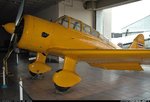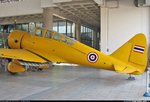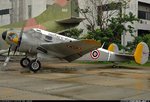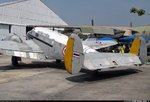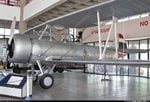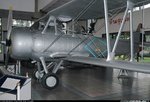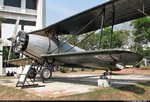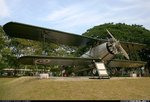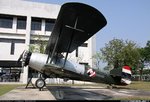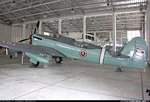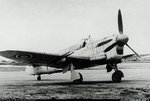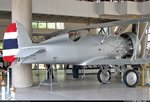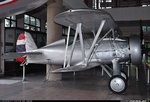They also used the Grumman Bearcat. Any info on that? By the way, great post...as always!
Navigation
Install the app
How to install the app on iOS
Follow along with the video below to see how to install our site as a web app on your home screen.
Note: This feature may not be available in some browsers.
More options
You are using an out of date browser. It may not display this or other websites correctly.
You should upgrade or use an alternative browser.
You should upgrade or use an alternative browser.
Royal Thai Air Force
- Thread starter gekho
- Start date
Ad: This forum contains affiliate links to products on Amazon and eBay. More information in Terms and rules
More options
Who Replied?- Thread starter
- #22
First flown in prototype form on 20 April 1938, the Tachikawa Ki-36 was a cantilever low-wing monoplane of all-metal basic structure, covered by a mix of light alloy and fabric. Landing gear was of fixed tailwheel type, the main units enclosed in speed fairings, and power was provided by a 336kW Hitachi Ha-13 radial engine. The two-man crew was enclosed by a long 'greenhouse' canopy and both men had good fields of view, that of the observer being improved by clear-view panels in the floor. The type was ordered into production in November 1938 as the Army Type 98 Direct Co- Operation Plane. Generally similar to the prototypes, the type was armed with two 7.7mm machine guns and introduced the more powerful Hitachi Ha-13a engine. When construction ended in January 1944, a total of 1,334 had been built by Tachikawa (862) and Kawasaki (472).
The handling characteristics and reliability of the Ki-36 made the army realize that it was ideal for use as an advanced trainer, resulting in development of the Ki-55, intended specifically for this role and having armament reduced to a single forward- firing machine-gun. Following the testing of a prototype in September 1939, the army ordered this aircraft as the Army Type 99 Advanced Trainer; when production was terminated in December 1943 a total of 1,389 had been built by Tachikawa (1,078) and Kawasaki (311). Both versions were allocated the Allied codename 'Ida', and the Ki-36 was first deployed with considerable success in China. However, when confronted by Allied fighters at the beginning of the Pacific War it was found to be too vulnerable, being redeployed in China where it was less likely to be confronted by such aircraft. It was also considered suitable for kamikaze use in the closing stages of the war, being modified to carry internally a bomb of up to 500kg.
In 1942, the Royal Thai Air force purchased twenty-four Tachikawa Ki-36 Ida trainers and designatewd them as Aircraft Type 89, now called Trainer Type 6 or nicknamed "Tachikawa". They served from 1942 to 1950.
Source: Tachikawa Ki-36 IDA - attacker pipitapan Royal Thai Air Force Museum - Tachikawa Ki36
The handling characteristics and reliability of the Ki-36 made the army realize that it was ideal for use as an advanced trainer, resulting in development of the Ki-55, intended specifically for this role and having armament reduced to a single forward- firing machine-gun. Following the testing of a prototype in September 1939, the army ordered this aircraft as the Army Type 99 Advanced Trainer; when production was terminated in December 1943 a total of 1,389 had been built by Tachikawa (1,078) and Kawasaki (311). Both versions were allocated the Allied codename 'Ida', and the Ki-36 was first deployed with considerable success in China. However, when confronted by Allied fighters at the beginning of the Pacific War it was found to be too vulnerable, being redeployed in China where it was less likely to be confronted by such aircraft. It was also considered suitable for kamikaze use in the closing stages of the war, being modified to carry internally a bomb of up to 500kg.
In 1942, the Royal Thai Air force purchased twenty-four Tachikawa Ki-36 Ida trainers and designatewd them as Aircraft Type 89, now called Trainer Type 6 or nicknamed "Tachikawa". They served from 1942 to 1950.
Source: Tachikawa Ki-36 IDA - attacker pipitapan Royal Thai Air Force Museum - Tachikawa Ki36
Attachments
- Thread starter
- #23
The Beech Model 18 or Beech 18 as it was known, started life in the 1930's as a civilian twin engine aircraft. First flown in 1937, it was later bought by the United States Army Air Corp (USAAC) in 1940 as a staff transport and designated them as C-45s. World War II was already raging in Europe and the British Royal Air Force (RAF) received some of these aircraft under Lend-Lease and designated theirs as Expediters. During the war there were multiple versions of this aircraft including a navigational trainer (AT-7 Navigator), a bombing/gunnery trainer (AT-11 Kansan) and similar versions for the Navy/Marine Corps (JRBs, SNBs). Some of these aircraft lasted in military service into the late 60's. Approximately 1800 aircraft were built for the U.S. military not including around 400 being rebuilt after the war. Civilian production ended in 1969 with around 8,000 total civilian and military aircraft being built. In 1947, six C-45s were purchased from the United States, priced at 325,515.60 baht each, designated Cargo Type 1.
Attachments
Good stuff!
vikingBerserker
Lieutenant General
I agree!
- Thread starter
- #26
First aircraft to bear the famous company name Vought Corsair, the initial O2U was little more than a developed version of the UO/FU series that incorporated an all-steel tube fuselage structure and introduced the Pratt Whitney Wasp radial engine. Deliveries to the US Navy began in 1927 and production totalled 291 in several versions. The Vought V-93S was the export version of the O3U-6 for Thailand. Twelve of these aircrafts were sold to the RTAF in 1934 following earlier purchases of the Vought V-65 and V-92 versions. They remained in service until 1945.
Source: http://peterlewisdesign.tripod.com/thaimuseum/vought.htm
Source: http://peterlewisdesign.tripod.com/thaimuseum/vought.htm
Attachments
- Thread starter
- #27
The Boripatra was a locally produced design, originating in 1927. They were built by the Aeronautical Service Workshops at Don Muang. There is this machine stored inside, and also another aircraft of this design displayed outside in front of the main building. The Boripara seems to be of standard mid-1920s design, with an uncowled Bristol Aspid radial engine mounted in front of a rugged circular fuselage. Fewer than 12 of these light bombers were built up until 1933. Their performance and their operational use seems to be unclear.
Source: Royal Thai Air Force Museum - Boripat
Source: Royal Thai Air Force Museum - Boripat
Attachments
vikingBerserker
Lieutenant General
That museum rocks!
futuredogfight
Senior Airman
Gave upon the awesome Thai P-36 Redirect Notice
- Thread starter
- #30
The Fairey Firefly was a British Second World War-era carrier-borne fighter aircraft and anti-submarine aircraft of the Fleet Air Arm (FAA). It was superior in performance and firepower to its predecessor, the Fulmar, but only entered operational service towards the end of the war. Designed around the contemporary FAA concept of a two-seat fleet reconnaissance/fighter, the pilot and navigator/weapons officer were housed in separate stations. The design proved to be sturdy, long-ranging and docile in carrier operations, although the limitations of a single engine in a heavy airframe reduced overall performance. The Fairey Firefly served in the Second World War as a fleet fighter but in postwar service, although it was superseded by more modern jet aircraft, the Firefly was adapted to other roles, including strike operations and anti-submarine warfare, remaining a mainstay of the FAA until the mid-1950s. Both the UK and Australia Fireflies flew ground attack operations off various aircraft carriers in the Korean War. In foreign service, the type was in operation with the naval air arms of Australia, Canada, India, and the Netherlands whose Fireflies carried out a few attack sorties as late as 1962 in Dutch New Guinea.
The Thai Navy received 10 Fairey Firefly FR.Mk.1 fighters and two T.Mk.2 in 1951. That Firefly arriverd to Air Force in late 1951 after a coup attempt by tha Navy to trow the Primeminster Phibun Songkhram away the Government decided to remove all planes from the Navy and gave it to the Royal Thai Air Force. The Firefly flew with the 71 Sqn /. Wing until the 1956 because a shortage os spare parts. The Navy newer ordered spare parts in the UK perhaps as revenge on the Air Force.
Source: Fairey Firefly,B.J.4,?? ? ( .. ), FIREFLY,???ó,Attack Aircraft,??, ??µ? ????, , , , Thai, Thailand, Aircraft
The Thai Navy received 10 Fairey Firefly FR.Mk.1 fighters and two T.Mk.2 in 1951. That Firefly arriverd to Air Force in late 1951 after a coup attempt by tha Navy to trow the Primeminster Phibun Songkhram away the Government decided to remove all planes from the Navy and gave it to the Royal Thai Air Force. The Firefly flew with the 71 Sqn /. Wing until the 1956 because a shortage os spare parts. The Navy newer ordered spare parts in the UK perhaps as revenge on the Air Force.
Source: Fairey Firefly,B.J.4,?? ? ( .. ), FIREFLY,???ó,Attack Aircraft,??, ??µ? ????, , , , Thai, Thailand, Aircraft
Attachments
- Thread starter
- #31
Boeing developed the aircraft as a private venture to replace the Boeing F3B and Boeing F2B with the United States Navy that was the first flight of the P-12 took place on June 25, 1928. The new aircraft was smaller, lighter and more agile than the ones it replaced but still used the Wasp engine of the F3B. This resulted in a higher top speed and overall better performance. As result of Navy evaluation 27 were ordered as the F4B-1, later evaluation by the United States Army Air Corps resulted in orders with the designation P-12. Boeing supplied the USAAC with 366 P-12's between 1929 and 1932. Production of all variants totalled 586.
Two Model 100Es were built for Siam (now Thailand) and were export versions of the P-12E. Owing to a ruling that export of aircraft currently in production for U.S. Forces could not be undertaken, the Boeing Model 234 designation was changed to 100E though general structure and performance was similar to that of the P-12E. Both 100Es were delivered in a dismantled state on November 10th 1931. The last surviving example (taken over by the Japanese during World War II), is currently preserved in the Thai Aeronautical Museum at Bangkok
Source: Boeing P-12 - Wikipedia, the free encyclopedia
Two Model 100Es were built for Siam (now Thailand) and were export versions of the P-12E. Owing to a ruling that export of aircraft currently in production for U.S. Forces could not be undertaken, the Boeing Model 234 designation was changed to 100E though general structure and performance was similar to that of the P-12E. Both 100Es were delivered in a dismantled state on November 10th 1931. The last surviving example (taken over by the Japanese during World War II), is currently preserved in the Thai Aeronautical Museum at Bangkok
Source: Boeing P-12 - Wikipedia, the free encyclopedia
Attachments
vikingBerserker
Lieutenant General
Excellent!
- Thread starter
- #33
Numerically the most important of all Japanese float seaplanes during World War II, the Aichi E13A monoplane (of which 1,418 were produced) originated in a naval staff specification issued to Aichi, Kawanishi and Nakajima in 1937 for a three-seat reconnaissance seaplane to replace the six-year-old Kawanishi E7K2 float biplane. A prototype was completed late in 1938 and after competitive trials with the Kawanishi E13K in December 1940 was ordered into production as the Navy Type 0 Reconnaissance Seaplane Model 1. Early aircraft were embarked in Japanese cruisers and seaplane tenders the following year and, carrying a single 250kg bomb apiece, flew a series of raids on the Hankow-Canton railway. Soon afterwards E13A1 floatplanes accompanied the Japanese 8th Cruiser Division for reconnaissance patrols during the strike against Pearl Harbor in December 1941. Thereafter, as production switched to Kyushu Hikoki KK at Zasshonokuma and accelerated, the seaplanes (codenamed 'Jake' by the Allies) were embarked in the battleships and cruisers of the Kantais (fleets), including the battleship Haruna and cruisers Chikuma and Tone of Vice Admiral Nagumo's Carrier Striking Force at the Battle of Midway. Because of mechanical problems with the ships' catapults there were delays in launching one of the four E13Als to search for the American carriers at dawn on the crucial 4 June 1942, depriving the Japanese of the vital initiative during the early stages of the assault on Midway. Furthermore the Chikuma's E13A1 was forced to return early when it suffered engine trouble, further reducing the all-important search area. One of the other 'Jake' pilots, from the cruiser Tone, eventually sighted the American fleet but at first failed to report the presence of carriers, causing a further 30-minute delay in arming the strike aircraft awaiting orders to launch from Japanese carriers. As it was, when the Americans launched their first strike, the pilots found the decks of the carriers Akagi, Kaga, Soryu and Hiryu clogged with aircraft which should have been attacking the American fleet. In all, it is estimated that by mid-1943 more than 250 E13A1s were at sea aboard Japanese ships, though their use was severely curtailed whenever American fighters were in evidence. Nevertheless they continued to serve right up to the end of the war, many of them being ultimately used in suicide attacks on the huge American invasion fleets closing on the Japanese homeland.
The most modern aircraft supplied to the Royal Thai Navy were six Aichi E13A-1s, three in 1942 and three more in June 1944. When the first Aichi's were delivered, the 1st naval Squadron was upgraded to a Naval Wing. The naval Wing had two bases, at Sattahip and at Chalong Bay. The Aichi E13A-1 was a three seat, twin float reconnaissance aircraft. The Aichi E13A-1 was known to the Allies as "Jake". Their endurance made them very suitable for long patrols over the Thai coastal waters and the Gulf of Thailand, in support of Imperial Japanese Navy operations. Included among the various kinds of missions flown by the Aichi E13A-1s were naval escort, patrol and SAR. The USAAF used B-24 Liberators for bombing missions and mine laying operations along the Thai coast. Apparently, the last three E13A-1s were a gift by the Imperial Japanese Navy, IJN, as a thank you for good support during its operations. According to an unofficial source, the IJN provided the three additional E13A-1s after RTN warships and coastal units had downed at least one USAAF B-24 Liberator. Again, little is known about the Royal Thai Navy use of its Aichis. One of them was destroyed at Chalong Bay on July 24/25, 1945. Five were still in service at the end of the war. In RTN service, the Aichi E13A-1's were painted in the standard IJN colours, dark green upper sides and light grey undersides, with black cowling and a yellow identification stripe. A white, or possibly yellow, roundel with a black (or dark blue) anchor were painted on the upper and lower surfaces of the wings and on the fuselage. A Thai national flag was also painted on the fin. Shortly after the end of the War, all the remaining Japanese aircraft in RTN service were decommissioned and withdrawn from use. This was due to an informal agreement with the Allies. The Royal Thai Navy continued to operate some light aircraft, but new combat aircraft in the shape of Fairey Firefly Mk I's weren't delivered until the late 'forties.
Source: Aichi E13A Jake - seaplane Japanese Aircraft in Thai Military Service
The most modern aircraft supplied to the Royal Thai Navy were six Aichi E13A-1s, three in 1942 and three more in June 1944. When the first Aichi's were delivered, the 1st naval Squadron was upgraded to a Naval Wing. The naval Wing had two bases, at Sattahip and at Chalong Bay. The Aichi E13A-1 was a three seat, twin float reconnaissance aircraft. The Aichi E13A-1 was known to the Allies as "Jake". Their endurance made them very suitable for long patrols over the Thai coastal waters and the Gulf of Thailand, in support of Imperial Japanese Navy operations. Included among the various kinds of missions flown by the Aichi E13A-1s were naval escort, patrol and SAR. The USAAF used B-24 Liberators for bombing missions and mine laying operations along the Thai coast. Apparently, the last three E13A-1s were a gift by the Imperial Japanese Navy, IJN, as a thank you for good support during its operations. According to an unofficial source, the IJN provided the three additional E13A-1s after RTN warships and coastal units had downed at least one USAAF B-24 Liberator. Again, little is known about the Royal Thai Navy use of its Aichis. One of them was destroyed at Chalong Bay on July 24/25, 1945. Five were still in service at the end of the war. In RTN service, the Aichi E13A-1's were painted in the standard IJN colours, dark green upper sides and light grey undersides, with black cowling and a yellow identification stripe. A white, or possibly yellow, roundel with a black (or dark blue) anchor were painted on the upper and lower surfaces of the wings and on the fuselage. A Thai national flag was also painted on the fin. Shortly after the end of the War, all the remaining Japanese aircraft in RTN service were decommissioned and withdrawn from use. This was due to an informal agreement with the Allies. The Royal Thai Navy continued to operate some light aircraft, but new combat aircraft in the shape of Fairey Firefly Mk I's weren't delivered until the late 'forties.
Source: Aichi E13A Jake - seaplane Japanese Aircraft in Thai Military Service
Attachments
vikingBerserker
Lieutenant General
Now taht one I did not know about.
Now taht one I did not know about.
Me either...
parsifal
Colonel
I had heard of them, but my source said "unconfirmed".....the photgraph sure confirms it.....thankyou gekho
Curtiss offered the Hawk 75 with 20mm and 23mm Madsen underwing pods. (Super-late reply, but I thought I might as well make it easy for anyone coming across this topic.)Thanks again BF.....what is the gun fitted to the wing????/ was that how they were delivered or was that armmaent fitted after delivery???
I don't have an information yet about weight, but the cannon apparently badly degraded performance and the pods were removed from most or all aircraft. Information is very, very thin. I'm hoping someone in Thailand, or with contacts, can eventually find something.
cammerjeff
Staff Sergeant
Late but here are some Thai Bearcat PicturesThey also used the Grumman Bearcat. Any info on that? By the way, great post...as always!
Source History of the Thai Flying Club and the beginnings of General Aviation in Thailand.
Last edited:
Users who are viewing this thread
Total: 1 (members: 0, guests: 1)
Similar threads
- Replies
- 4
- Views
- 497

